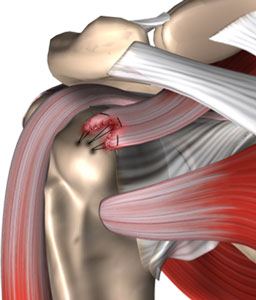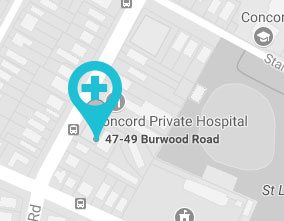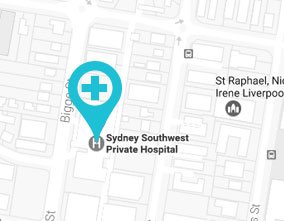Rotator Cuff Tear
The Condition
Description
The rotator cuff is a group of muscles and tendons that support the shoulder joint and enable a wide range of motion. A forceful injury can cause one or more of these tendons to tear, a condition called rotator cuff tear. The tear may be partial or complete. Rotator cuff tears are one of the most common causes of shoulder pain in middle aged adults and older individuals.

Causes
Rotator cuff tears usually occur due to pressure on the rotator cuff from part of the shoulder blade (scapula) as the arm is lifted. It may occur with repeated use of the arm for overhead activities, while playing sports or during motor accidents.
Impact
Rotator cuff injuries can be painful and weaken the shoulder joint preventing you from carrying out routine activities which involve raising the arm and lifting.
Anatomy
The rotator cuff is a group of 4 muscles in the shoulder joint including the supraspinatus, infraspinatus, teres minor and subscapularis. These muscles originate in the scapula and attach to the head of the humerus through tendons. The rotator cuff forms a sleeve around the humeral head and glenoid cavity, providing stability to the shoulder joint while enabling a wide range of movements.
Symptoms
Rotator cuff tears cause severe pain, weakness of the arm, and a crackling sensation when moving the shoulder into certain positions. There may be stiffness, swelling, loss of movement, and tenderness in the front of the shoulder.
Diagnosis
Your surgeon will diagnose a rotator cuff tear based on a physical examination and imaging studies such as X-rays or MRI (magnetic resonance imaging). Rotator cuff tears are best viewed on MRI.
Untreated
Rotator cuff injuries that do not receive treatment may cause stiffness and weakening of the shoulder joint with progressive degeneration. Certain injuries become more difficult to treat with time.
Treatments
Options
Rotator cuff injuries are mostly treated by conservative measures. Surgery is required in certain cases. Treatments include
- Rest
- Shoulder sling
- Injections of a steroid (cortisone) and a local anesthetic to help decrease the inflammation and pain
- Certain exercises
- Rotator cuff repair surgery
Surgery
Surgery is recommended if symptoms are persistent and mostly in cases of large or complete tendon tears. Rotator cuff repair may be performed by open surgery or arthroscopy. During surgery, space for the rotator cuff tendons is increased and the cuff tear is repaired using suture anchors, which help in attaching the tendons to the bone. Following surgery, you may be advised to practice motion and strengthening exercises.
Benefits of arthroscopy
Arthroscopy is a less invasive procedure which may be performed on an outpatient basis.
Procedure in Detail
Surgery is usually performed under general anesthesia. An open repair is recommended in cases of large or complex tears. A large incision is made over the shoulder joint and the overlying deltoid muscle is detached for better vision and access. The open method makes it easier to remove bone spurs or perform a tendon transfer if necessary.
Arthroscopy involves the placement of a miniature camera called an arthroscope into the shoulder joint. Magnified images from the arthroscope are displayed on a screen and help your surgeon use miniature instruments to carry out the procedure. A few small incisions are made to admit the arthroscope and instruments into the joint.
A mini-open repair may also be performed where a single 3-5 cm incision is made over the shoulder and an arthroscope is used to carry out certain procedures such as removal of a bone spur. Rotator cuff repair is then performed through the same incision under direct vision after removing the arthroscope.
Preparation
Before surgery, you will receive a complete medical evaluation. Your doctor will discuss your surgery in detail. You should notify your doctor of any allergies or any medications you are taking. You may be asked to stop taking certain medication prior to surgery. A physical therapist can discuss rehabilitation. You may have to arrange for someone to help you with certain activities following surgery.
Post-operative information
Following surgery. you will experience some pain for which your doctor will prescribe medications. Depending on your level of pain, you may receive anti-inflammatory medications, local anesthetics or opioids. If your pain does not resolve within a few weeks you should notify your doctor. Avoid smoking as it can delay the healing of tissues.
Outcome
Following surgery and rehabilitation, you should have less pain and improved shoulder strength and function.
Post-op stages of recovery and care plan
A physical therapy program is recommended to help you get back to your daily routine. It will help you regain shoulder strength and movement. Your recovery plan occurs in stages. The initial stage involves immobilization in a sling for 4-6 weeks to allow the repaired tendon time to heal. The next stage involves passive exercises to improve movement of the joint. The final stage involves strengthening exercises for the shoulder. It is usually started at 8-12 weeks after surgery.
Down-time, lifestyle or off-work duration
Complete recovery can take 4-6 months depending on various factors including the extent of the injury, your age, your adherence to post-op instructions and physical therapy etc.
Prognosis
Although surgery is usually successful at relieving pain and improving function, return to activities such as sports may take a while. Some patients may occasionally develop weakness, stiffness or chronic pain. Your prognosis improves if your rotator cuff muscles are not very weak before surgery, your tear is not large, you are below 65 years of age, you do not smoke and are committed to postoperative and rehabilitation instructions.
Costs
Our staff will discuss cost details, insurance and other funding options with you in detail.
Research
Research articles on rotator cuff injuries:
Hughes JD, Hughes JL, Bartley JH, Hamilton WP, Brennan KL. Infection Rates in Arthroscopic Versus Open Rotator Cuff Repair. Orthopaedic Journal of Sports Medicine. 2017;5(7):2325967117715416. doi:10.1177/2325967117715416.





